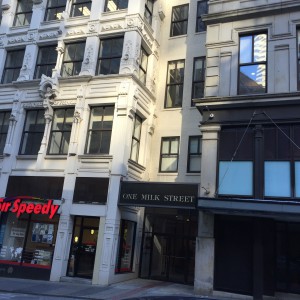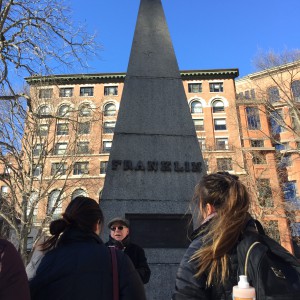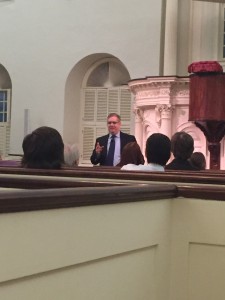When walking through the streets of Downtown Boston, it is likely that you will come across a monument/statue that is dedicated to BENJAMIN FRANKLIN- one of the Founding Fathers of the United States and one of the most influential and intelligent men throughout American history.

Benjamin Franklin, the son of Josiah Franklin and Abiah Folger, was born on January 17, 1706 at One Milk Street in Boston, Massachusetts (Pictured Above). This building, however, is not the precise location in which Franklin was born due to the fact that the original building burned down in a major fire in back in 1811. One the second story of the modernized building, a carving of Franklin’s bust is able to be seen. Underneath this carving reads “Birthplace of Benjamin Franklin”; this allows all who see to remember the significance of One Milk Street. When the modernized building was built, it just so happened to also be the location of “Sir Speedy”. “Sir Speedy” is a print shop. That is quite ironic due to the fact that Franklin worked in (as well as gained skill and success in) a printing press as a teenager as an apprentice to his elder brother. The significance of this building is immense and though he did not live there his entire life (he later ventured off to Philadelphia) – it was where he began.

The Granary Burial Grounds, located on Tremont Street, is the resting place/ gravesite/monument that is dedicated to the parents of Benjamin Franklin- Josiah Franklin and Abiah Folger. Pictured above is the renovated “obelisk” (a skinny pyramid-shaped monument) that was constructed by citizens of Boston in 1827 after the original gravestones, that were constructed by Benjamin Franklin, himself, had succumbed to natural ware and tear. When obelisk was erected, an inscription that referenced the lives of Josiah and Abiah, in quick and influential summary, along with the birth/death dates. Benjamin Franklin is not buried here, however a few of his siblings were laid to rest with their parents here. The Granary Burial Grounds is also home to Samuel Adams, Crispus Attucks, James Otis, John Hancock and Paul Revere. Had Benjamin been buried there, instead of in Philadelphia (where many of his successes took place)- he would have definitely been in great company being laid to rest alongside many other influential Americans.

This full body statue/monument of Benjamin Franklin is located at the Old City Hall, which is now home to Ruth’s Chris Steakhouse on School Street. This is one of the most iconic statues in the city of Boston and it just so happens to be one of my favorites. Constructed in 1856, each part of the statue has its own significance. Underneath the full body statue is a square-shaped monument; this piece of the square monument has pictures engraved on all four sides. One side has a photograph of him working with electricity and there is a latin script below it, on another side, he is pictured signing the Declaration of Independence along with others who signed it as well, there then is a picture of him working in a printing press and lastly there is a photograph of his working on the Treaty of Paris.
Benjamin Franklin was man of many skills and much intelligence. He is one to be remembered and all of these these monuments are the perfect way to remember him by.









